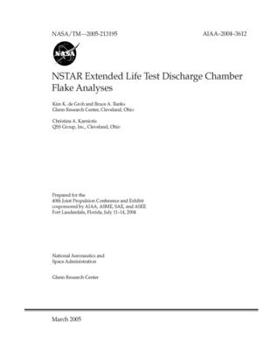NSTAR Extended Life Test Discharge Chamber Flake Analysis
The Extended Life Test (ELT) of the NASA Solar Electric Propulsion Technology Readiness (NSTAR) ion thruster was concluded after 30,352 hours of operation. The ELT was conducted using the Deep Space 1 (DS1) back-up flight engine, a 30 cm diameter xenon ion thruster. Post-test inspection of the ELT engine revealed numerous contaminant flakes distributed over the bottom of the cylindrical section of the anode within the discharge chamber (DC). Extensive analyses were conducted to determine the source of the particles, which is critical to the understanding of degradation mechanisms of long life ion thruster operation. Analyses included: optical microscopy (OM) and particle length histograms, field emission scanning electron microscopy (FESEM) combined with energy dispersive spectroscopy (EDS), and atomic oxygen plasma exposure tests. Analyses of the particles indicate that the majority of the DC flakes consist of a layered structure, typically with either two or three layers. The flakes comprising two layers were typically found to have a molybdenum-rich (Mo-rich) layer on one side and a carbon-rich (C-rich) layer on the other side. The flakes comprising three layers were found to be sandwich-like structures with Mo-rich exterior layers and a C-rich interior layer. The presence of the C-rich layers indicates that these particles were produced by sputter deposition build-up on a surface external to the discharge chamber from ion sputter erosion of the graphite target in the test chamber. This contaminant layer became thick enough that particles spalled off, and then were electro-statically attracted into the ion thruster interior, where they were coated with Mo from internal sputter erosion of the screen grid and cathode components. Atomic oxygen tests provided evidence that the DC chamber flakes are composed of a significant fraction of carbon. Particle size histograms further indicated that the source of the particles was spalling of carbon flakes from downstream surfaces. Analyses of flakes taken from the downstream surface of the accelerator grid provided additional supportive information. The production of the downstream carbon flakes, and hence the potential problems associated with the flake particles in the ELT ion thruster engine is a facility induced effect and would not occur in the space environment. deGroh, Kim K. and Banks, Bruce A. and Karniotis, Christina A. Glenn Research Center NASA/TM-2005-213195, E-14694, AIAA Paper 2004-3612 WBS 22-319-20-E1 NASA SPACE PROGRAMS; SOLAR ELECTRIC PROPULSION; TECHNOLOGY UTILIZATION; LIFE (DURABILITY); CONTAMINANTS; FLAKES; THRUST CHAMBERS; DEEP SPACE 1 MISSION; XENON; LIGHT EMISSION; CARBON; CYLINDRICAL BODIES; ION ENGINES; SPUTTERING; MOLYBDENUM; TUNGSTEN; SCANNING ELECTRON MICROSCOPY
Format:Paperback
Language:English
ISBN:B08F6TFB65
ISBN13:9798672675541
Release Date:January 1
Publisher:Independently Published
Length:36 Pages
Weight:0.24 lbs.
Dimensions:0.1" x 8.5" x 11.0"
Customer Reviews
0 rating





